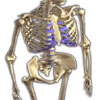Drug halts organ damage in inflammatory genetic disorder
A new study shows that Kineret (anakinra), a medication approved for the treatment of rheumatoid arthritis, is effective in stopping the progression of organ damage in people with neonatal-onset multisystem inflammatory disease (NOMID). This rare and debilitating genetic disorder causes persistent inflammation and ongoing tissue damage. The research was performed by scientists at the National Institute of Arthritis and Musculoskeletal and Skin Diseases (NIAMS), part of the National Institutes of Health.
NOMID affects numerous organs and body systems, including the skin, joints, eyes, and central nervous system. The first sign of the disease is often a rash that develops within the first weeks of life. Other problems, including fever, meningitis, joint damage, vision and hearing loss, and mental retardation, can follow. Kineret, one of a relatively new class of drugs known as biologic response modifiers or biologics, blocks the activity of interleukin-1 (IL-1), a protein made by cells of the immune system. IL-1 is overproduced in NOMID and a number of other diseases, leading to damaging inflammation. Previous work by the same NIAMS group showed that blocking IL-1 was effective in relieving symptoms of NOMID. However, this is the first study to show that Kineret works over the long-term and, at higher doses, can also control damage that often results in vision and hearing loss, and brain lesions.
“Inflammation prolonged over many years will eventually cause irreversible damage and loss of function,” said lead author Dr. Raphaela Goldbach-Mansky of the NIAMS Translational Autoinflammatory Disease Section.
For example, inflammation of the cochlea — a tiny structure of the inner ear — was found to be responsible for hearing loss in people with NOMID. Thinning of the optic nerve caused by inflammation-related pressure in the brain has been identified as a cause of vision loss.
“We knew we could effectively block inflammation in the inner ear and in the brain and eyes. The next step was to find out if we could sufficiently prevent the progression of hearing or vision loss,” said Goldbach-Mansky.
The group sought the answers to their questions in the study published online in Arthritis & Rheumatism. Study participants, who ranged in age from 10 months to 42 years, were treated with daily doses of Kineret based on body weight — 1 to 5 milligrams of Kineret per kilogram of body weight (1 to 5 mg/kg/day) — for at least 36 months and as long as 60 months. Disease activity was monitored with blood tests to measure C-reactive protein, a marker for inflammation in the body, and by daily diaries kept by the patients or their parents. The researchers also used sensitive MRI imaging methods to assess inflammation in the inner ear and brain.
Researchers found the initial Kineret doses used were insufficient to control organ inflammation, but by increasing the dose, they were able to do so. By preventing organ inflammation, scientists were able to preserve organ function in most patients. In addition, the scientists found ways to predict who is at greatest risk of hearing and vision loss.
“The few patients in the study who had hearing loss were also the ones who continued to have inflammation in the inner ear,” said the study’s first author Dr. Cailin H. Sibley. “We also found that people who had thin optic nerves when we assessed their vision were more likely to lose vision than those who had thick optic nerves, simply because they had already lost fibres due to untreated disease and, therefore, started with a huge disadvantage.”
These findings point to the importance of early diagnosis and treatment to keep organ damage from developing. “We are continuing the study with an emphasis on enrolling very young children to prospectively show that we can prevent any organ damage from developing if we start treatment early in life,” Goldbach-Mansky said.
Because IL-1 is needed to fight infections, there has been concern that blocking it with high doses of Kineret might leave the body vulnerable to infections. But overall, the study drug was well tolerated. “While we have seen infections in the study, none were serious enough to discontinue the drug, and all healed well with appropriate treatment.”
While Kineret is not a cure for NOMID — its effects last only as long as the drug is taken — the study offers hope for people with the disease. “Without Kineret, people with NOMID are at risk of progressive organ damage that results in hearing and vision loss, cognitive impairment and, in many cases, early death. As many as 20 percent of children with this genetic disorder do not live to adulthood,” said Goldbach-Mansky. “This study shows that treatment over five years is safe and effective, and can prevent organ damage.”
(Source: US Deptartment of Health & Human Services: Arthritis & Rheumatism)
More information
 | For more information on osteoporosis, including its effect on bones and the importance of nutrition and dairy, as well as some useful videos and tools, see Osteoporosis. |
Dates
Created by:

 Login
Login














